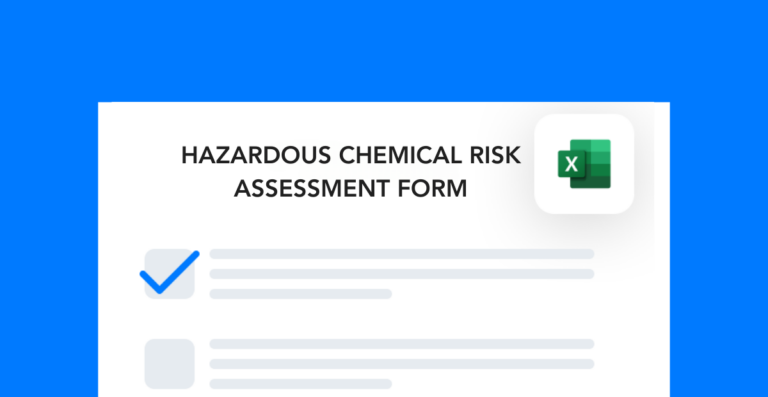As a seasoned safety professional, one of your paramount tasks is to evaluate the risk level of on-site hazardous materials. In this article, we’ll explore critical steps, considerations, and best practices that guide safety professionals in hazmat risk assessment. Drawing insights from industry standards, regulatory frameworks, and real-world expertise, let’s jump into the intricacies of risk evaluation.
Step 1: Identification and documentation
The first and foundational step in evaluating the risk level of hazardous materials is the comprehensive identification and documentation of these substances. You must possess a detailed inventory of all hazardous materials present on site, including chemicals, gases, and other dangerous substances.
Material Safety Data Sheets (MSDS) or Safety Data Sheets (SDS): These documents provide essential information about the properties, hazards, handling procedures, and emergency response protocols for each hazardous material. Access and maintain up-to-date MSDS or SDS for all substances, ensuring that your team can readily access this data.
Chemical Inventory System: Implement a robust chemical inventory system that catalogs the quantities, locations, and usage patterns of hazardous materials. This system should also include information on storage conditions, expiration dates, and disposal requirements.
Step 2: Classification and categorization
Once we identify the hazardous materials onsite, the next step is to classify and categorize them based on their intrinsic properties and potential risks. This process assists in prioritizing and focusing risk assessment efforts.
Hazard Classification: Assess each hazardous material’s inherent hazards, considering factors such as toxicity, flammability, reactivity, and corrosiveness. Utilize established classification systems like the Globally Harmonized System of Classification and Labelling of Chemicals (GHS) to standardize your evaluations.
Categorization: Categorize the materials into risk groups based on their hazard classification, quantity, and potential consequences. This categorization can help determine the scrutiny required for each material, from low-risk substances to highly hazardous chemicals.
Step 3: Risk assessment and quantification
With hazardous materials identified and categorized, it’s time to assess and quantify the associated risks. This phase involves a comprehensive analysis of potential hazards and their likelihood of occurrence.
Risk Matrix: Risk matrices are commonly used in risk assessment processes. You can find information and guidance on risk matrices from reputable occupational health and safety organizations or other authoritative sources in your region. Here is an excellent resource provided by a Certified Safety Professional from NASA.
Probability and Consequence Analysis: Evaluate the probability of accidents or incidents involving hazardous materials and the potential consequences. This analysis informs decisions on risk mitigation measures and emergency response planning.
Step 4: Mitigation and control measures
Based on the assessed risks, formulate and implement effective mitigation and control measures. The goal is to minimize the likelihood of incidents and reduce their potential impact.
Engineering Controls: Consider engineering controls such as ventilation systems, containment measures, and safety equipment to prevent or minimize hazardous material releases. Ensure these controls are properly designed, maintained, and inspected.
Administrative Controls in Hazmat Management: Administrative controls, such as safety protocols, training programs, and SOPs in hazmat management, are fundamental aspects of ensuring safety. Specific regulations and guidelines for hazmat administrative controls can vary by jurisdiction and industry. To access information on administrative controls in hazmat management, it is advisable to refer to relevant occupational safety and environmental protection agencies, industry-specific guidelines, or authoritative sources in your region.
Step 5: Emergency response planning
A robust emergency response plan is the cornerstone of hazmat risk assessment. Ensure that your plan is comprehensive and tailored to the types of materials onsite.
Evacuation Plans: Develop evacuation plans that consider the scope of potential incidents and outline procedures for safely evacuating personnel and the community if necessary.
Communication Protocols: Establish clear communication protocols for notifying emergency responders, authorities, and affected parties during a hazardous materials incident. Regular drills and training exercises are essential to test the effectiveness of these protocols. Communication protocols should be contained in your facilities’ emergency action plan (OSHA 1910.38).
Step 6: Environmental impact assessment
In addition to human safety, assess the potential environmental impact of hazardous materials. Consider the risk of spills, leaks, or releases that could contaminate soil, water bodies, or the atmosphere.
Environmental Regulations: Familiarize yourself with environmental regulations that govern hazardous materials. The Environmental Protection Agency (EPA) in the United States guides hazardous substance releases and cleanup efforts.
Remediation Plans: Develop remediation plans that outline procedures for containing, mitigating, and remediating environmental damage in the event of a release. Collaborate with environmental agencies and experts to ensure compliance and efficient response.
Step 7: Ongoing monitoring and improvement
HazMat risk assessment is not a one-time task; it’s an ongoing commitment to safety and preparedness. Continuously monitor and assess the effectiveness of control measures and response plans.
Regular Audits: Conduct regular audits and inspections to verify compliance with safety protocols, evaluate the equipment’s condition, and identify improvement areas.
Lessons Learned: Incorporate lessons from incidents, near misses, and emergencies into your risk assessment process. Adjust control measures and plans accordingly to prevent recurrence.
Evaluating the risk level of hazardous materials onsite is a complex yet indispensable aspect of safety management. By meticulously identifying, documenting, classifying, and categorizing materials, assessing and quantifying risks, implementing mitigation measures, crafting comprehensive emergency response plans, addressing environmental impact, and committing to ongoing monitoring and improvement, you can confidently navigate the challenges posed by hazardous materials.
Remember, as a safety professional, your expertise and commitment to rigorous risk evaluation play a pivotal role in safeguarding the well-being of your team, the community, and the environment. Embrace the culture of safety, and let it guide you on this journey of risk assessment and mitigation.




